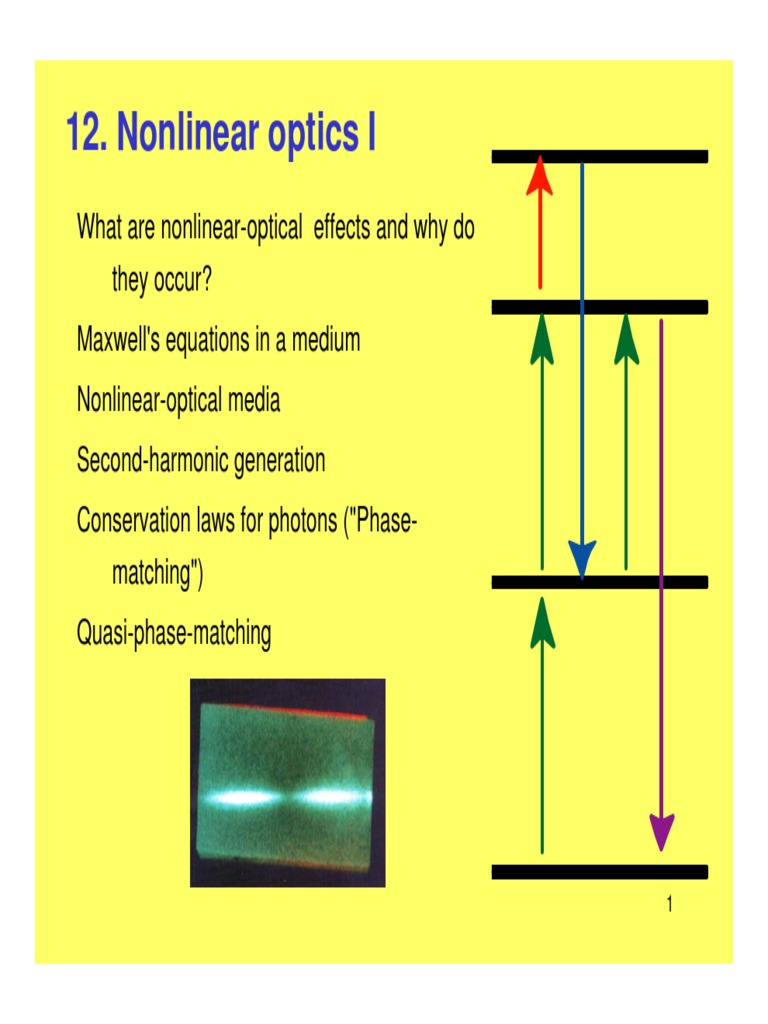The realm of optics, the study of light and its interactions with matter, stands at the forefront of many scientific and technological advancements. Among its many fascinating branches, non-linear optics emerges as a vibrant tapestry woven with intricate phenomena, contrasting sharply with its linear counterpart. To grasp the essence of non-linear optics, one must transcend the conventional boundaries of perception and venture into a domain where light behaves not merely as a wave but as a dynamic participant in a nuanced dance with the medium through which it traverses. This exploration unfurls a myriad of physical implications that resonate deeply within the scientific landscape.
At the heart of non-linear optics lies the principle that the response of a medium to an electromagnetic field is not merely proportional to the amplitude of the incident light. In linear optics, such as the refraction of light through a prism, the laws governing light’s behavior are predictable and consistent. However, in non-linear optics, this relationship manifests as a complex interplay, akin to the intricate choreography of a ballet, where each movement is influenced by preceding actions. Light, upon entering a non-linear medium, interacts with its atomic structure, causing variations in the material’s refractive index. This deviation becomes pivotal in generating novel optical phenomena.
The consequences of this non-linear behavior are captivating, leading to the emergence of effects such as second-harmonic generation (SHG). Imagine a musical symphony where a fundamental note finds resonance, allowing it to produce harmonics that enrich the composition. Similarly, in SHG, photons of a specific frequency combine their energies within a non-linear medium, yielding new photons at twice the original frequency. This phenomenon is not merely a curiosity; it opens the door to numerous applications in laser technology, medical imaging, and telecommunications. The ability to generate coherent light at different wavelengths serves as a cornerstone for advancements in photonics.
Furthermore, one must consider the phenomenon of self-focusing, which can be likened to a river converging into a narrow gorge. As light propagates through a non-linear medium, its intensity can induce a refractive index change that causes the light to focus itself, creating a filament of intense illumination. This self-focusing capacity is critical for a diverse range of applications, from high-intensity laser systems utilized in material processing to the fascinating dynamics of solitons. These solitary wave packets maintain their shape while traveling at a constant speed, showcasing the fascinating interplay of non-linear dynamics in optics.
The ramifications of non-linear optics extend to the field of optical switching, an integral part of modern digital communication systems. Imagine a switch that operates not with mechanical action but through the very presence of light itself. In non-linear optical materials, the refractive index can be modulated by the intensity of the light passing through. This ability allows the creation of devices that can turn signals on and off with remarkable speed and efficiency, reshaping data transmission and processing across various platforms. Such systems promise to significantly enhance the capacity and speed of communication networks, thereby revolutionizing how information is shared and processed.
The intriguing concept of optical solitons showcases another dimension of non-linear optics; these waves, formed under specific conditions, exhibit remarkable stability despite the non-linear interactions they undergo. The analogy of a perfectly balanced tightrope walker can be drawn here—employing a sophisticated understanding of dynamics to maintain equilibrium. Solitons possess the remarkable ability to traverse long distances without deforming, which makes them indispensable in long-haul fiber-optic communication systems. The quest for transmitting information has thus entered a new era where soliton dynamics play a crucial role in enabling efficient data flow.
Additionally, the fascinating phenomenon of optical Kerr effect embodies yet another aspect of non-linear optics. The electric field of light influences the polarization of a medium, altering its refractive index. This effect can be harnessed to create ultra-fast optical switches and modulators that operate at the speed of light, enabling real-time processing of vast amounts of information. The capability to manipulate light with unparalleled precision is not merely a scientific achievement but a gateway toward innovative technologies that can shape our future.
Yet, as one probes deeper into the mysteries of non-linear optics, the concept of chaos unravels an interesting narrative. The non-linear interactions can lead to unpredictable behaviors akin to a weather system; tiny changes in initial conditions can yield vastly different outcomes. Understanding and managing chaos in optical systems is not just an academic curiosity; it offers pathways to new technologies, such as secure communication channels and sophisticated imaging techniques that capitalize on the inherent unpredictability of light.
Non-linear optics encapsulates a multifaceted panorama that transcends linear interpretations, inviting scientists and engineers alike to explore its depths. Each phenomenon within this domain narrates a story of interconnectedness, where light and matter engage in a perpetual and harmonious interaction. As researchers delve further, they discover that the physical interpretations of non-linear optics extend beyond mere theoretical frameworks; they influence practical applications that enhance our technological landscape, expanding the horizons of our understanding and capabilities. The ever-evolving relationship between light and matter in non-linear optics beckons an array of applications, each with the potential to redefine the limits of innovation.
In sum, the physical meaning of non-linear optics is a rich tapestry woven with complex interactions and captivating phenomena. As we unravel these threads, we uncover a realm where light behaves not just as a passive entity but as an active participant within the universe, illuminating pathways to unprecedented discoveries and innovations.












